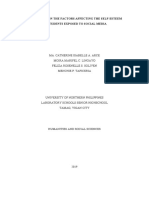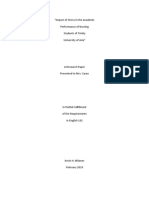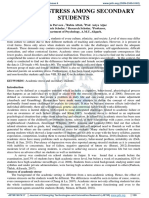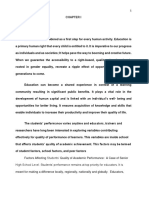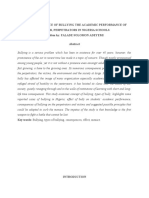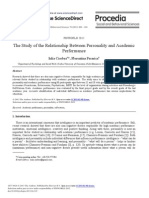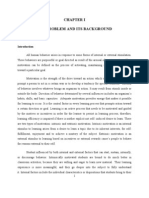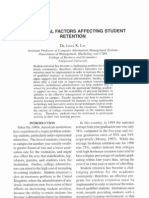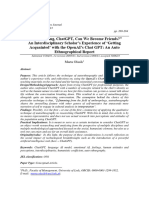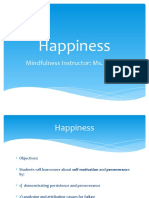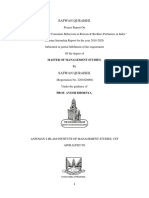Professional Documents
Culture Documents
Survey On Stress and Coping Strategies of Post Graduate Students
Original Title
Copyright
Available Formats
Share this document
Did you find this document useful?
Is this content inappropriate?
Report this DocumentCopyright:
Available Formats
Survey On Stress and Coping Strategies of Post Graduate Students
Copyright:
Available Formats
Volume 5, Issue 5, May – 2020 International Journal of Innovative Science and Research Technology
ISSN No:-2456-2165
Survey on Stress and Coping Strategies of Post
Graduate Students
B.Y. Kavitha1, C. Swetha2, Shruti Joshi3, V. Deepthi4, D. Mounika5
1
Head, Department of Biotechnology, A. V. College of Arts, Science &Commerce
2&3
Assistant Professor, Department of Biotechnology, A. V. College of Arts, Science &Commerce
4&5
Postgraduate Students, Department of Biotechnology, A. V. College of Arts, Science &Commerce
Hyderabad, India
Abstract:- In the present day of globalization, a lot of students are focused for the analysis that helps in
competition, creativity, innovation and adaptability is understanding the level of adjustment and the academic
required to survive in society which creates stress. Stress performance of students for an improved living.
is the condition of emotional pressure of an individual by
socioeconomic & environmental constraints. It is caused The causes of stress or stressors, generally considered
mainly by physical & emotional tensions which lead to among the students include academics, financial aspects,
change in feelings and physical state of the body. The career, time management, relationships, etc. The stressors
stress usually shows a negative impact on health, which discussed in this paper are related to academic performance,
results in anger, depression, poor concentration, anxiety, poor understanding capacity, assignments,
headache, bowel disorder, skin rashes, insomnia, etc. competition in placements, relationship with friends &
The stress in students mainly comes from academic family and status of the family as the most significant
performance, relationship with family and friends and possibilities.
career exploration that leads to psychological, physical,
and behavioral problems in the individual. The younger II. LITERATURE REVIEW
generation should enhance their stress management
strategies to overcome the pressure and lead a healthy Every person faces different stress like work stress,
life. The postgraduate students are more susceptible to family stress, financial stress, or any other type in which
experience stress because of the tension related to their work stress is the biggest source of stress. Stress is a feeling
immediate professional career. The main objective of the of the individuals when they have to struggle to meet the
study is to find out the stress levels among postgraduate demands in financial, relationships, work and any other
students of different disciplines. In this paper, we situation. Perceived stress in the youth or college students is
conducted a survey by structured google form for the an alarming inclination. There are many factors which
analyzation of the sources, causes, stress signs, health causes stress- emotional, congenital, economic, social,
issues faced & coping methodologies that help to make a biological and psychological. The students face academic
healthy life by minimizing the negative impact of stress due to competition among students for scoring the
stressor. highest marks, academic failures, assignments with
deadlines, insufficient pocket money leading to mental
Keywords:- Stress, Stressor, Coping Strategies, Symptoms of health problems among them in collegiate life. These
Stress, Postgraduate Students. students carry the stress not only with them but also to their
family members. The stress is proportional to the existence
I. INTRODUCTION of the stressor, due to which students experience a
substantial amount of stress, that leads to negative academic
Stress is a change of physical or mental disturbance in outcomes or health problems.
the body which makes your emotions express like feeling
frustrated, showing anger, becoming nervous, over These stressors were analyzed in many different fields
sweating, etc. Stress is a state of mind, when a person feels of students. Any individual showing the symptoms of
experiencing a situation requires more resources than the depression, increase or decrease in appetite, restlessness,
ability of the individual. As the younger generation in tension, anxiety, unable to concentrate are the victims of
the present competitive society is more stressed, they stress. Stress initiate a complex reaction of neurological and
experience psychological symptoms like depression, attempt endocrinological system of the body where adrenaline or
to suicide tendencies, and many more according to various noradrenaline hormones respond to sudden situations that
articles and statistical analysis. The stress is categorized into arises by behavioral, physiological reactions. The immune
two types, acute or short-term stress and chronic or long- defense mechanism of the body is activated by a
term stress. The chronic stress leads to many health issues sympathetic nervous system against the stressors and
like high blood pressure, heart disease, diabetes, obesity, releases adrenaline hormone to overcome stress. The
acne or eczema, depression or anxiety, menstrual problems, negative impact of stress varies from person to person and
and so on. Considering all the factors, young college also depend on their coping strategies adopted. There are
IJISRT20MAY252 www.ijisrt.com 638
Volume 5, Issue 5, May – 2020 International Journal of Innovative Science and Research Technology
ISSN No:-2456-2165
two coping strategies, approach style coping and avoidance IV. RESULTS AND DISCUSSION:
style coping. Balancing academics, personal life,
relationships and other peer activities by students is very The respondents are from the different colleges
difficult. The difficulty alters the situation to a challenge in from faculty of Arts, Science & Commerce given under
case of career in students. the inclusion criteria of colleges in Hyderabad. The first
section of questionnaire is demographic factors. The
Rationale of the Study: table 1 shows the total number of distribution of samples
The rationale of the study is to find out the different that consists of 263 respondents. By taking all the
factors of stress, expression of stress, coping technologies to respondents into consideration, 72.2% are females and
overcome the stress among the postgraduate students. In the 27.8% are males (Fig.1). The respondents in survey
present scenario of the education system, all the school and shows that there is almost equal participation of both
college students are exposed to various stressors and the first year and second year students of 20-23 years old
level of stress changes from individual to individual, teacher (given in table.2) of which 21-year age group students
& institution. Based on the factors the following objectives are more in number (Fig.2)
are listed out.
Objectives of the Study: Gender N %
To list out the major causes and symptoms of stress Female 190 72.2
affecting the postgraduate students.
To identify the effect of the level of stressors on the Male 73 27.8
physical and mental health of individuals.
To know the strategies and cope up to overcome Total 263 100
stress by the postgraduate students.
Table 1:- Distribution according to Gender
III. RESEARCH METHODOLOGY:
Coverage of study:
This study covers the stress levels among the
postgraduate students by an online questionnaire survey.
The target group for the survey includes the students of
Arts, Science & Commerce streams studying in various
affiliated and constituent colleges under Osmania
university located in Hyderabad. The exclusion criterion
includes the university colleges.
Data collection or sources of data:
The data and information are gathered by an online
questionnaire survey by using google platform for
generating responses of the post graduate students. The Fig 1
data is collected based on primary data-Questionnaire
and secondary data- Internet, Journals, Books etc. The
questionnaire includes demographic factors, causes of Age Number %
stress, signs of stress, relation of stress and health &
coping strategies 20 23 8.7
Sample size: 21 92 35
The population size considered is 22,230 at 95%
confidence level and Margin of error being 5%, the 22 80 30.4
targeted sample size n = 138, while we have received
responses from 263 samples. The google structured 23 68 25.9
questionnaire is sent to different college post graduate
students given under inclusion criteria. Total 263 100
Table 2:- Age in years
IJISRT20MAY252 www.ijisrt.com 639
Volume 5, Issue 5, May – 2020 International Journal of Innovative Science and Research Technology
ISSN No:-2456-2165
Hours of study Number of students %
0-2 125 47.5
2-4 85 32.3
4-6 41 15.6
6-8 10 6.8
>8 2 0.8
Total 263 100
Fig 2
Table 4:- Hours of study
Each course students of different streams are prone
to different stresses based upon their curriculum
designed as per the requirement of their discipline of
study. The respondents in the study are faculty of science
(76%), Faculty of Arts (4.9%) & Faculty of commerce
(19%) (Table 3). The fig.3 shows that respondents from
Master of Science are more in number.
Course Number %
M.Sc. 200 76
M.A 13 4.9
M.Com 50 19 Fig 4
Total 263 100
Study time Number of students % of students
Table 3:- Academic course stream
Late night hours 136 51.7
Early morning 127 48.3
Hours
Total 263 100
Table 5:- Study hours- early or night
Fig 3
Long duration of study and sleeping hours may or
may not be linked to increased stress. Thus, to
understand and analyze the Stress level in the students,
their sleeping, working and studying pattern was
focused. From total respondents, 51.7% students were
night owls (table 5), maximum of them work & study for
around 0-2 hours (47.5%) (Table 4) and sleep for around
6-8 hours a day (62.4%) (Table 6). (Fig. 4, 5, 6) Fig 5
IJISRT20MAY252 www.ijisrt.com 640
Volume 5, Issue 5, May – 2020 International Journal of Innovative Science and Research Technology
ISSN No:-2456-2165
Hours of study Number of students %
0-2 3 1.1
2-4 4 1.5
4-6 56 21.3
6-8 164 62.4
8-10 31 11.8
>10 5 1.9
Total 263 100
Table 6:- Study hours- early or night Fig 6
The general causes included in the stress questionnaire shows that students with low financial background are prone to
more stress comparatively. In the present society, the cost of education is high, due to which students are unable to maintain
balance between the family financial status and their aspiration of attaining the higher education. Out of all the respondents,
almost 47.9 % students feel that family financial status is causing stress. Next to financial status, other general causes are
choice of career (41.1%) and employment opportunities (35%) showing maximum respondents (Table 7, Fig. 7)
General factors which cause stress Number of students % of students
Family financial status 126 47.9
Parental belief 59 22.4
Placement opportunities 92 35
Career option/Aspiration to get job 108 41.1
Health issues(self) 48 18.3
Health issues of family and friends 35 13.3
relationship with family 59 22.4
Social Relationship with Friends 43 16.3
Social media profile 19 7.2
Table 7:- General factors which cause stress
Fig 7
IJISRT20MAY252 www.ijisrt.com 641
Volume 5, Issue 5, May – 2020 International Journal of Innovative Science and Research Technology
ISSN No:-2456-2165
In academic stressor, competition in performance, performance(21.3%), Uncertainty of placements
work/project deadlines, project presentations and public (15.6%), long working/studying hours(17.9%) in
speaking almost show the similar number of responses decreasing order of the responses of the students.(Table
comprising 23-26% followed by academic 8 , Fig. 8)
Academic stress factors Number of students % of students
Work/project deadlines 65 24.7
Long working/studying hours 47 17.9
Academic performance 56 21.3
Viva voice 39 14.8
Public speaking & project presentations/stage fear 62 23.6
Team workloads 11 4.2
Duration of course 22 8.4
High fee structure/cost of study 44 16.7
Uncertainty - placements 41 15.6
Creativity/Uniqueness 14 5.3
Competition in performance 68 25.9
Table 8:- Academic Stress Factors
Fig 8
An individual is different from another individual in expressing the stress signs and depends on time of exposure of
stressor. Some may show early sign of stress like insomnia, frustration, worrying etc., but few signs of stress often appeared in
most of the individuals include anger (31.6%), Tears (30.4%), Agitated Irritability (25.5%), Sleeplessness (22.4%) by
maximum number of respondents. These signs of mood irritability or mood swings appear at instances based upon situations.
Only few signs of stress are taken into consideration in the questionnaire given in the table 9 (fig.9)
IJISRT20MAY252 www.ijisrt.com 642
Volume 5, Issue 5, May – 2020 International Journal of Innovative Science and Research Technology
ISSN No:-2456-2165
Regular stress symptoms Number of students % of students
Upset/Tearfulness 80 30.4
Agitated Irritability 67 25.5
Guilty/Worthless 43 16.3
Empty/Blank/Numb 33 12.5
Isolated/separated 24 9.1
Lacking of self confidence 55 20.9
Hopelessness/Despair 24 9.1
Exhausted/Tired/Unable to sleep 59 22.4
Anger 83 31.6
Suicidal tendency 6 2.3
None 50 19
Table 9:- Stress symptoms
Fig 9
The post graduate students are usually in the age group of 20-23 which is a very tender age to get any health issues, but
then it is clearly understood by the responses that stress is linked with health. Maximum numbers of respondents are facing
headache/migraine comprising 51% of sample size. Other health problems of respondents showing maximum number are
loneliness, poor concentration, depression, back ache (fig.10). The stress on students is also making them experience
hypertension, stomach, skin disorders, dizziness but in low proportion given in table 10.
IJISRT20MAY252 www.ijisrt.com 643
Volume 5, Issue 5, May – 2020 International Journal of Innovative Science and Research Technology
ISSN No:-2456-2165
Health problems faced due to stress Number of Students % of students
Headache/migraine 134 51
Hypertension 15 5.7
Stomach Upset/bowel disorder 18 6.8
Chest pain 16 6.1
Back ache 37 14.1
Skin problems 19 7.2
Diabetes 0 0
Respiratory Problems/breathing difficulty 6 2.3
Fatigue/Dizziness/Drowsiness 19 7.2
Depression 48 18.3
Poor concentration 61 23.2
Loneliness 48 18.3
None 64 24.3
Table 10:- Health problems faced due to stress
Fig 10
The coping strategies help in reducing the stress in students. The maximum number of respondents are with intention of
getting psychological support from family and friends (35.4%) and being optimistic (34.6%). The other coping strategies
mentioned in questionnaire is to divert them by taking active participation in activities to get distracted, sharing views with
family and friends, Meditation, and so on. Among the respondents, the chance of getting addicted to smoking and boozing
comprises about 1-3%. (Table 11, Fig. 11)
IJISRT20MAY252 www.ijisrt.com 644
Volume 5, Issue 5, May – 2020 International Journal of Innovative Science and Research Technology
ISSN No:-2456-2165
Coping strategies Number of students % of students
psychological support from friends and families 93 35.4
advice of health care professional 12 4.6
Mentoring (Faculty, Professors) 12 4.6
Diverting in other activities 78 29.7
strategic planning to deal with situation 60 22.8
Chill out/Making fun of the situation 57 21.7
Be optimistic 91 34.6
Exercises/Sports 51 19.4
Participation in University clubs and societies 8 3
relaxation postures/Breathing exercises 19 7.2
Meditate/Pray 43 16.3
Drink alcohol 7 2.7
Smoke Cigarettes 3 1.1
Eat junk/Comfort food 25 9.5
Use any medication 3 1.1
Vacation trips 27 10.3
Resort to pet therapy 4 1.5
Others 20 7.6
None 27 10.3
Table 11:- Coping strategies practiced to reduce stress
Fig 11
IJISRT20MAY252 www.ijisrt.com 645
Volume 5, Issue 5, May – 2020 International Journal of Innovative Science and Research Technology
ISSN No:-2456-2165
V. CONCLUSION:
Stress in post graduate students is caused by many
different factors with numerous negative health issues. From
the above results, it is clear that headache/migraine, poor
concentration, depression, back pain are more common
signs of stress among the students. It is also helping us to
realize that long working hours and less sleeping hours can
be harmful to health. It is analyzed from the above data that,
the major general causes of stress in postgraduate students
are financial situations, choice of career, employment
opportunities and major academic causes are competition,
deadlines of project, academic performance. The uncertainty
of getting placed with good academic performance to
survive in the present competitive environment of the
society is one of the major factors for the stress of young
postgraduates. Bouncing back from stress using different
coping strategies is the good idea to overcome the distress.
Some coping strategies identified by majority of young
postgraduates to cope up from stress are psychological and
emotional support from the family and friends and the other
is meditation, yoga & exercises. The meditation and
yoga comprise asana, pranayama, Dhyana which revitalize
the body, mind & spirit to lead healthy lives. This research
paper addresses the limited factors or causes of stress, the
stress symptoms experienced with relation to the health
issues faced and coping strategies adopted by professional
post graduate students. It would be further protracted to find
the comparative stress with additional quantitative and
qualitative analysis of diverse experiences among various
discipline professionals.
REFERENCES
[1]. Cohen S, Janicki Deverts D, Miller GE. Psychological
stress and disease. Journal of the American Medical
Association. 2007;298(14):1685‒1687.
[2]. Schafer, 1996; Fisher, 1994; Altmaier, 1983;
Greenberg & Valletutti, 1980
[3]. Nordqvist C. Why stress happens and how to manage
it. Medical News Today. 2017.
[4]. Sax, L. J. (1997). Health trends among college
freshmen. Journal of American College Health, 45(6),
252-262.
[5]. Fairbrother, K. & Warn, J. (2003). Workplace
dimension: Stress and Job satisfaction. J. Management
Psychol, 18(1), 8-21.
[6]. Britz, J. and E. Pappas (2010). “Sources and outlets of
stress among university students: Correlations between
stress and unhealthy habits.” Undergraduate Research
Journal for the Human Sciences 9(1).
[7]. Bhargava, D., Trivedi, H. (2018). A Study of Causes
of Stress and Stress Management among Youth. IRA
International Journal of Management & Social
Sciences (ISSN 2455-2267), 11(3), 108-
117.doi:http://dx.doi.org/10.21013/jmss.v11.n3.p1
[8]. Moos, R. H. (1993). Coping response inventory (Youth
form).Psychological Assessment Resources. USA:
Odesa.
IJISRT20MAY252 www.ijisrt.com 646
You might also like
- The Science of Likability - Charm Wit Humor and THDocument89 pagesThe Science of Likability - Charm Wit Humor and THsssssssssssssssssssssssso100% (11)
- Facilitating Emotional Self Regulation in Preschool ChildrenDocument36 pagesFacilitating Emotional Self Regulation in Preschool ChildrenIndra Daria100% (2)
- Understanding The Sacral Chakra - Second ChakraDocument7 pagesUnderstanding The Sacral Chakra - Second ChakraMarata SteveNo ratings yet
- Let's Explore How Sad Sadness Is: A Journey Through The Abyss of DepressionDocument12 pagesLet's Explore How Sad Sadness Is: A Journey Through The Abyss of DepressionStephanie Ann ValenciaNo ratings yet
- The Practice and Science of Drawing by Speed, HaroldDocument182 pagesThe Practice and Science of Drawing by Speed, HaroldGutenberg.org100% (3)
- Personal DevelopmentDocument3 pagesPersonal DevelopmentMarynell MoralitaNo ratings yet
- 5 Stages of CoachingDocument15 pages5 Stages of CoachingJack Welch100% (2)
- TheroleofguidanceandcounsellingineffectiveteachingandlearninginschoolsDocument14 pagesTheroleofguidanceandcounsellingineffectiveteachingandlearninginschoolsHasna AzizahNo ratings yet
- Study Anxiety and Scholastic PerformanceDocument56 pagesStudy Anxiety and Scholastic PerformanceDave DoncilloNo ratings yet
- The Identification of Students' Stressors in Academic Work in The English and French Program at University of NariñoDocument30 pagesThe Identification of Students' Stressors in Academic Work in The English and French Program at University of NariñoDaniela HernandezNo ratings yet
- Stress Among University StudentsDocument8 pagesStress Among University Studentssyed laeeq haider100% (1)
- AIINEDUCATIONDocument9 pagesAIINEDUCATIONOlavario Jennel PeloNo ratings yet
- 2Document28 pages2Arvic John BresenioNo ratings yet
- Boyer PDFDocument213 pagesBoyer PDFSom Mai EmaiNo ratings yet
- Practical Research 11 Humss C ArcelingayosoliventapiceriaDocument21 pagesPractical Research 11 Humss C Arcelingayosoliventapiceriakai asuncionNo ratings yet
- Pursuing HappinessDocument21 pagesPursuing HappinessmircammNo ratings yet
- Academic Achievement in Relation To Metacognition and Problem Solving Ability Among Secondary School StudentsDocument14 pagesAcademic Achievement in Relation To Metacognition and Problem Solving Ability Among Secondary School StudentsAnonymous CwJeBCAXp100% (1)
- Social Case Work Principles and ComponentsDocument6 pagesSocial Case Work Principles and Components1508 Ima VR100% (1)
- Mba Research Project ReportDocument63 pagesMba Research Project ReportDeepak SharmaNo ratings yet
- Chapters 1 3Document44 pagesChapters 1 3Azriel Mae BaylonNo ratings yet
- Change ReadinessDocument27 pagesChange Readinessdiamond76198100% (1)
- Introduction To Qualitative Research: PartoneDocument25 pagesIntroduction To Qualitative Research: Partonepsych2085100% (1)
- TruancyDocument16 pagesTruancyMing yiNo ratings yet
- A Qualitative Analysis of Sources of Teacher StressDocument1 pageA Qualitative Analysis of Sources of Teacher StressZulliana HasanNo ratings yet
- 2001 - Maslach, Schaufeli, Leiter - Job Burnout PDFDocument28 pages2001 - Maslach, Schaufeli, Leiter - Job Burnout PDFedu76No ratings yet
- Depression, Anxiety and AcademDocument5 pagesDepression, Anxiety and AcademSassy BlaireNo ratings yet
- StressDocument15 pagesStresssanthana LakshmiNo ratings yet
- The Problem and Its BackgroundDocument12 pagesThe Problem and Its BackgroundPogiNo ratings yet
- Depression Among College StudentsDocument4 pagesDepression Among College StudentsJeyNo ratings yet
- Relationship Between Procrastination and Academic PerformanceDocument5 pagesRelationship Between Procrastination and Academic PerformanceNanang HardiansyahNo ratings yet
- Making Sense of Academic Failure from Private and Public School StudentsDocument31 pagesMaking Sense of Academic Failure from Private and Public School StudentsNikki CarnalanNo ratings yet
- Self Confidence IndiaDocument5 pagesSelf Confidence IndiajosekinNo ratings yet
- Academic Stress in Relation To Academic Performance of High School Students in The New Normal EducationDocument26 pagesAcademic Stress in Relation To Academic Performance of High School Students in The New Normal EducationAJHSSR JournalNo ratings yet
- Bibliography PDFDocument3 pagesBibliography PDFlarenNo ratings yet
- Biology Form 4: Cell DivisionDocument29 pagesBiology Form 4: Cell Divisionzuraidarazak255No ratings yet
- Impact of Stress in The Academic PerformanceDocument9 pagesImpact of Stress in The Academic PerformanceKevin H. Milanes100% (2)
- Academic Stress and Grade 12 Notre Dame of Cotabato STEM Students' Academic PerformanceDocument43 pagesAcademic Stress and Grade 12 Notre Dame of Cotabato STEM Students' Academic PerformanceJacob RoalesNo ratings yet
- Coping Strategy of Male and Female Grocery Workers - LADocument36 pagesCoping Strategy of Male and Female Grocery Workers - LALawrence Albert MacaraigNo ratings yet
- Factors that Cause Depression and Impact School Performance in Grade 10 StudentsDocument9 pagesFactors that Cause Depression and Impact School Performance in Grade 10 StudentsAimee HernandezNo ratings yet
- Academic Optimism Among Senior High SchoolDocument10 pagesAcademic Optimism Among Senior High SchoolLorenz Moises EnrickNo ratings yet
- Stressors Among Grade 12 HUMSS Students On Pandemic LearningDocument21 pagesStressors Among Grade 12 HUMSS Students On Pandemic LearningEllaNo ratings yet
- Stress Intensity of A Nursing Students Regarding ToDocument10 pagesStress Intensity of A Nursing Students Regarding ToRajaAnantaNo ratings yet
- The Life of The Laters: Students Procrastination in Accomplishing Academic Deadlines in Online LearningDocument16 pagesThe Life of The Laters: Students Procrastination in Accomplishing Academic Deadlines in Online LearningPsychology and Education: A Multidisciplinary JournalNo ratings yet
- AnxietyDocument37 pagesAnxietyazza atyaNo ratings yet
- Chapter 2Document19 pagesChapter 2Niles VentosoNo ratings yet
- AiraDocument44 pagesAiraJamillah Napao ManiulitNo ratings yet
- Academic StressDocument5 pagesAcademic StressAklile TsegaNo ratings yet
- Relationship between academic achievement and self-esteemDocument5 pagesRelationship between academic achievement and self-esteemaivy rose de ocampo100% (1)
- STRESss SDocument44 pagesSTRESss SSneha Maru100% (1)
- Phys HealthDocument19 pagesPhys HealthJulianna Bartalus100% (1)
- The Relationship of Mental Health and Academic Performance of College StudentsDocument5 pagesThe Relationship of Mental Health and Academic Performance of College StudentsLpc Geremy Impas OwelNo ratings yet
- Chapter 5 SampleDocument16 pagesChapter 5 SampleLalaine Angel Alejo100% (1)
- Factors Affecting Students' Academic PerformanceDocument62 pagesFactors Affecting Students' Academic PerformanceRheeanne Mae AmilasanNo ratings yet
- Physics Formula SheetDocument4 pagesPhysics Formula SheetHemanthNo ratings yet
- Difficulties and Research Students' Attitude - A Multifaceted AnalysisDocument14 pagesDifficulties and Research Students' Attitude - A Multifaceted AnalysisamjadarainNo ratings yet
- Anxiety and Depression Among Students of A Medical College in Saudi ArabiaDocument6 pagesAnxiety and Depression Among Students of A Medical College in Saudi Arabiahadyan39No ratings yet
- BENEFITSDocument2 pagesBENEFITSJeric PinedaNo ratings yet
- The Menace of Bullying The Academic Performance of Victims, Perpetrators in Nigeria SchoolsDocument29 pagesThe Menace of Bullying The Academic Performance of Victims, Perpetrators in Nigeria SchoolsFalade Solomon AdeyemiNo ratings yet
- Emotional Intelligence, Stress, and Nursing StudentsDocument9 pagesEmotional Intelligence, Stress, and Nursing StudentsMae Anne Yabut Roque-CunananNo ratings yet
- Effects of Depression To Grade 11 and Grade 12 Senior High School Students of Ama Computer Learning Center of Antipolo Campus 2019Document8 pagesEffects of Depression To Grade 11 and Grade 12 Senior High School Students of Ama Computer Learning Center of Antipolo Campus 2019Jane SandovalNo ratings yet
- Running Head: Literature Review 1Document6 pagesRunning Head: Literature Review 1Loise GakiiNo ratings yet
- SynopsisDocument14 pagesSynopsisAmrit VallahNo ratings yet
- Academic pressure on students causes stress and mental health issuesDocument8 pagesAcademic pressure on students causes stress and mental health issuesДимаш СерикNo ratings yet
- Relationship Between Personality and Academic PerformanceDocument5 pagesRelationship Between Personality and Academic Performancereferatelee1No ratings yet
- Final Final Final Final ThesisDocument29 pagesFinal Final Final Final Thesismae- athenaNo ratings yet
- Psychological Resilience and Coping Strategies of High School Students Based On Certain Variables PDFDocument16 pagesPsychological Resilience and Coping Strategies of High School Students Based On Certain Variables PDFCarla Si MarianNo ratings yet
- Factors Affecting Depression in Senior High StudentsDocument4 pagesFactors Affecting Depression in Senior High StudentsJee En BeeNo ratings yet
- Coping mechanisms of STEM studentsDocument43 pagesCoping mechanisms of STEM studentsDaniella PeñalosaNo ratings yet
- Institutional Factors Affecting Student RetentionDocument12 pagesInstitutional Factors Affecting Student RetentionMaria BalochNo ratings yet
- The Relationship Between Self-Esteem and Academic AchievementDocument16 pagesThe Relationship Between Self-Esteem and Academic AchievementARMIA ZAHEER / UPMNo ratings yet
- Causes of student stress, its effect on academic success and stress managementDocument25 pagesCauses of student stress, its effect on academic success and stress managementt3emo shikihiraNo ratings yet
- Stress Management Among Post Graduate StudentsDocument15 pagesStress Management Among Post Graduate StudentsInternational Journal of Innovative Science and Research TechnologyNo ratings yet
- Formulation and Evaluation of Poly Herbal Body ScrubDocument6 pagesFormulation and Evaluation of Poly Herbal Body ScrubInternational Journal of Innovative Science and Research TechnologyNo ratings yet
- Comparatively Design and Analyze Elevated Rectangular Water Reservoir with and without Bracing for Different Stagging HeightDocument4 pagesComparatively Design and Analyze Elevated Rectangular Water Reservoir with and without Bracing for Different Stagging HeightInternational Journal of Innovative Science and Research TechnologyNo ratings yet
- Explorning the Role of Machine Learning in Enhancing Cloud SecurityDocument5 pagesExplorning the Role of Machine Learning in Enhancing Cloud SecurityInternational Journal of Innovative Science and Research TechnologyNo ratings yet
- A Review: Pink Eye Outbreak in IndiaDocument3 pagesA Review: Pink Eye Outbreak in IndiaInternational Journal of Innovative Science and Research TechnologyNo ratings yet
- Design, Development and Evaluation of Methi-Shikakai Herbal ShampooDocument8 pagesDesign, Development and Evaluation of Methi-Shikakai Herbal ShampooInternational Journal of Innovative Science and Research Technology100% (3)
- Studying the Situation and Proposing Some Basic Solutions to Improve Psychological Harmony Between Managerial Staff and Students of Medical Universities in Hanoi AreaDocument5 pagesStudying the Situation and Proposing Some Basic Solutions to Improve Psychological Harmony Between Managerial Staff and Students of Medical Universities in Hanoi AreaInternational Journal of Innovative Science and Research TechnologyNo ratings yet
- A Survey of the Plastic Waste used in Paving BlocksDocument4 pagesA Survey of the Plastic Waste used in Paving BlocksInternational Journal of Innovative Science and Research TechnologyNo ratings yet
- Electro-Optics Properties of Intact Cocoa Beans based on Near Infrared TechnologyDocument7 pagesElectro-Optics Properties of Intact Cocoa Beans based on Near Infrared TechnologyInternational Journal of Innovative Science and Research TechnologyNo ratings yet
- Auto Encoder Driven Hybrid Pipelines for Image Deblurring using NAFNETDocument6 pagesAuto Encoder Driven Hybrid Pipelines for Image Deblurring using NAFNETInternational Journal of Innovative Science and Research TechnologyNo ratings yet
- Cyberbullying: Legal and Ethical Implications, Challenges and Opportunities for Policy DevelopmentDocument7 pagesCyberbullying: Legal and Ethical Implications, Challenges and Opportunities for Policy DevelopmentInternational Journal of Innovative Science and Research TechnologyNo ratings yet
- Navigating Digitalization: AHP Insights for SMEs' Strategic TransformationDocument11 pagesNavigating Digitalization: AHP Insights for SMEs' Strategic TransformationInternational Journal of Innovative Science and Research TechnologyNo ratings yet
- Hepatic Portovenous Gas in a Young MaleDocument2 pagesHepatic Portovenous Gas in a Young MaleInternational Journal of Innovative Science and Research TechnologyNo ratings yet
- Review of Biomechanics in Footwear Design and Development: An Exploration of Key Concepts and InnovationsDocument5 pagesReview of Biomechanics in Footwear Design and Development: An Exploration of Key Concepts and InnovationsInternational Journal of Innovative Science and Research TechnologyNo ratings yet
- Automatic Power Factor ControllerDocument4 pagesAutomatic Power Factor ControllerInternational Journal of Innovative Science and Research TechnologyNo ratings yet
- Formation of New Technology in Automated Highway System in Peripheral HighwayDocument6 pagesFormation of New Technology in Automated Highway System in Peripheral HighwayInternational Journal of Innovative Science and Research TechnologyNo ratings yet
- Drug Dosage Control System Using Reinforcement LearningDocument8 pagesDrug Dosage Control System Using Reinforcement LearningInternational Journal of Innovative Science and Research TechnologyNo ratings yet
- The Effect of Time Variables as Predictors of Senior Secondary School Students' Mathematical Performance Department of Mathematics Education Freetown PolytechnicDocument7 pagesThe Effect of Time Variables as Predictors of Senior Secondary School Students' Mathematical Performance Department of Mathematics Education Freetown PolytechnicInternational Journal of Innovative Science and Research TechnologyNo ratings yet
- Mobile Distractions among Adolescents: Impact on Learning in the Aftermath of COVID-19 in IndiaDocument2 pagesMobile Distractions among Adolescents: Impact on Learning in the Aftermath of COVID-19 in IndiaInternational Journal of Innovative Science and Research TechnologyNo ratings yet
- Securing Document Exchange with Blockchain Technology: A New Paradigm for Information SharingDocument4 pagesSecuring Document Exchange with Blockchain Technology: A New Paradigm for Information SharingInternational Journal of Innovative Science and Research TechnologyNo ratings yet
- Perceived Impact of Active Pedagogy in Medical Students' Learning at the Faculty of Medicine and Pharmacy of CasablancaDocument5 pagesPerceived Impact of Active Pedagogy in Medical Students' Learning at the Faculty of Medicine and Pharmacy of CasablancaInternational Journal of Innovative Science and Research TechnologyNo ratings yet
- Intelligent Engines: Revolutionizing Manufacturing and Supply Chains with AIDocument14 pagesIntelligent Engines: Revolutionizing Manufacturing and Supply Chains with AIInternational Journal of Innovative Science and Research TechnologyNo ratings yet
- Enhancing the Strength of Concrete by Using Human Hairs as a FiberDocument3 pagesEnhancing the Strength of Concrete by Using Human Hairs as a FiberInternational Journal of Innovative Science and Research TechnologyNo ratings yet
- Exploring the Clinical Characteristics, Chromosomal Analysis, and Emotional and Social Considerations in Parents of Children with Down SyndromeDocument8 pagesExploring the Clinical Characteristics, Chromosomal Analysis, and Emotional and Social Considerations in Parents of Children with Down SyndromeInternational Journal of Innovative Science and Research TechnologyNo ratings yet
- Supply Chain 5.0: A Comprehensive Literature Review on Implications, Applications and ChallengesDocument11 pagesSupply Chain 5.0: A Comprehensive Literature Review on Implications, Applications and ChallengesInternational Journal of Innovative Science and Research TechnologyNo ratings yet
- Teachers' Perceptions about Distributed Leadership Practices in South Asia: A Case Study on Academic Activities in Government Colleges of BangladeshDocument7 pagesTeachers' Perceptions about Distributed Leadership Practices in South Asia: A Case Study on Academic Activities in Government Colleges of BangladeshInternational Journal of Innovative Science and Research TechnologyNo ratings yet
- Advancing Opthalmic Diagnostics: U-Net for Retinal Blood Vessel SegmentationDocument8 pagesAdvancing Opthalmic Diagnostics: U-Net for Retinal Blood Vessel SegmentationInternational Journal of Innovative Science and Research TechnologyNo ratings yet
- The Making of Self-Disposing Contactless Motion-Activated Trash Bin Using Ultrasonic SensorsDocument7 pagesThe Making of Self-Disposing Contactless Motion-Activated Trash Bin Using Ultrasonic SensorsInternational Journal of Innovative Science and Research TechnologyNo ratings yet
- Natural Peel-Off Mask Formulation and EvaluationDocument6 pagesNatural Peel-Off Mask Formulation and EvaluationInternational Journal of Innovative Science and Research TechnologyNo ratings yet
- Beyond Shelters: A Gendered Approach to Disaster Preparedness and Resilience in Urban CentersDocument6 pagesBeyond Shelters: A Gendered Approach to Disaster Preparedness and Resilience in Urban CentersInternational Journal of Innovative Science and Research TechnologyNo ratings yet
- Handling Disruptive Behaviors of Students in San Jose National High SchoolDocument5 pagesHandling Disruptive Behaviors of Students in San Jose National High SchoolInternational Journal of Innovative Science and Research TechnologyNo ratings yet
- Self Confidence 160218143249Document11 pagesSelf Confidence 160218143249Rehan AwanNo ratings yet
- Impact of Immersion On The CSS Skills ToDocument29 pagesImpact of Immersion On The CSS Skills Toarba.peralta.upNo ratings yet
- Moral Injury, Light Traits Impact Healthcare Workers' Mental Health During COVIDDocument18 pagesMoral Injury, Light Traits Impact Healthcare Workers' Mental Health During COVIDMihaela-AlexandraGhermanNo ratings yet
- Learning StylesDocument9 pagesLearning StylesRoxnne LupangoNo ratings yet
- The Emotional Brain: A Concise History of Affective NeuroscienceDocument18 pagesThe Emotional Brain: A Concise History of Affective NeurosciencesausechehNo ratings yet
- Assumptions of ArtDocument3 pagesAssumptions of ArtWinter SummerNo ratings yet
- "Good Morning, ChatGPT, Can We Become Friends " An Interdisciplinary Scholar's Experience of Getting Acquainted' With The OpenAI's Chat GPT An Auto Ethnographical ReportDocument16 pages"Good Morning, ChatGPT, Can We Become Friends " An Interdisciplinary Scholar's Experience of Getting Acquainted' With The OpenAI's Chat GPT An Auto Ethnographical ReportKrinka V BakovićNo ratings yet
- Dism Midterm ReviewerDocument10 pagesDism Midterm ReviewerNikolle GucelaNo ratings yet
- Munchausen by Proxy Abuse and PTSDDocument4 pagesMunchausen by Proxy Abuse and PTSDbing bongNo ratings yet
- 38 Stock Market Trading PsychologyDocument14 pages38 Stock Market Trading PsychologyAani RashNo ratings yet
- Happiness: Mindfulness Instructor: Ms. Rand HannaDocument25 pagesHappiness: Mindfulness Instructor: Ms. Rand HannaRand HannaNo ratings yet
- Signs of Low Self-EsteemDocument8 pagesSigns of Low Self-EsteemPriyankkaaNo ratings yet
- Blue Eyes TechnologyDocument39 pagesBlue Eyes TechnologyRaktim RoyNo ratings yet
- Psy409 AssignmentDocument4 pagesPsy409 AssignmentNain TaraNo ratings yet
- ESL drama class focuses on student performanceDocument10 pagesESL drama class focuses on student performanceevaNo ratings yet
- 9.1 Entry 11 AdemilokunDocument21 pages9.1 Entry 11 Ademilokuntaiwo gbolagadeNo ratings yet
- Empathy 2Document3 pagesEmpathy 2api-486515075No ratings yet
- Internship ReportDocument26 pagesInternship ReportSafwan QuraishiNo ratings yet














